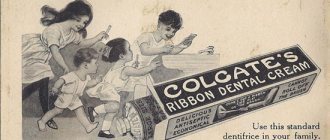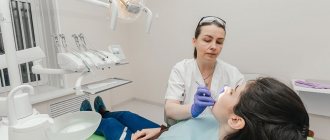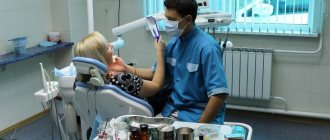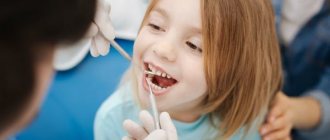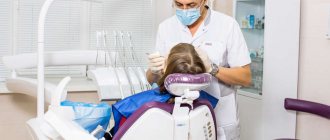| [organizational and legal form, name of organization, enterprise] | I approve [position, signature, full name of the manager or other official authorized to approve the job description] [day month Year] M.P. |
Job description of a dental therapist [name of organization, enterprise, etc.]
This job description has been developed and approved in accordance with the provisions of the Labor Code of the Russian Federation, Decree of the Government of the Russian Federation of February 14, 2003 N 101 “On the length of working hours of medical workers depending on the position and (or) specialty they occupy”, resolutions of the State Committee for Labor of the USSR and Presidium of the All-Union Central Council of Trade Unions dated October 25, 1974 N 298/P-22 “On approval of the list of industries, workshops, professions and positions with hazardous working conditions, work in which gives the right to additional leave and a shortened working day” and other regulations, regulating labor relations.
Responsibilities of a dental therapist
A qualified doctor must directly report to the job description of a dental therapist. A person with a higher medical education in the specialty “Dentistry” can be hired for the position. The doctor should know:
- basics of asepsis and antiseptics;
- basics of organizing timely medical care;
- instrument sterilization technique;
- methods of providing first aid for bleeding, painful shock, collapse;
- resuscitation techniques;
- types of modern dental equipment, as well as instruments.
A qualified dentist must be familiar with the psychology of professional communication and be able to reassure the patient.
The main responsibilities of a dental therapist include:
- carrying out the initial patient appointment;
- qualified medical examination of the patient’s oral cavity;
- collection of biomaterial for further research;
- preparing the patient for physiotherapeutic procedures;
- providing first aid for oral injuries;
- performing dental restoration;
- treatment of diseases that do not require surgical intervention;
- maintaining medical records;
- storage and accounting of received drugs;
- conducting consultations with doctors of related specialties.
The instructions of the dentist-therapist also provide for rights. The doctor can make proposals to management to improve his medical activities, make decisions independently within his competence, and also supervise the work of junior subordinate employees. A dentist-therapist has the right to improve his qualifications and undergo training in related medical specialties.
The physician is responsible for the performance of his duties. The working hours of a dental therapist should not exceed 39 hours per week.
I. General provisions
1. A person with a higher education – specialty (“Dentistry”) is appointed to the position of dentist. For professional growth and assignment of a qualification category, the fulfillment of criteria corresponding to the specialty is required. Main ways to improve qualifications:
— advanced training programs;
— professional retraining programs;
— internships;
— trainings in simulation centers;
— use of modern distance educational technologies (educational portal and webinars);
— participation in congresses, conferences, master classes
2. There are no work experience requirements.
3. Additional requirements for permission to work:
— undergoing mandatory preliminary (upon employment) and periodic medical examinations (examinations), as well as extraordinary medical examinations (examinations) in the manner established by the legislation of the Russian Federation;
- absence of a criminal record and (or) the fact of criminal prosecution or termination of criminal prosecution on rehabilitative grounds.
4. Appointment to the position of a dentist, as well as dismissal from it, is made by order of the head of the organization.
5. A dentist should know:
5.1. The biological role of the dentofacial region, the biomechanics of chewing, age-related changes in the maxillofacial region, the peculiarities of the influence of the external and internal environment on it
5.2. Basic principles of diagnosing infectious diseases, medical indications for hospitalization of patients with infectious diseases
5.3. Topographic anatomy of the head, maxillofacial region, features of blood supply, innervation and lymphatic system, structure of teeth, embryology of the dentofacial region, main disorders of embryogenesis
5.4. Etiology, pathogenesis, diagnosis of common diseases
5.5. The relationship between the structure and functioning of the dental system and disorders of the nasopharynx, respiratory and digestive systems, and musculoskeletal system
5.6. Basic issues of normal and pathological physiology of the dental system, its relationship with the functional state of other body systems and the levels of their regulation
5.7. Methods for diagnosing diseases of the temporomandibular joint and salivary glands in children and adults
5.8. Normal structure of teeth, jaws and structural disorders due to dental and facial anomalies
5.9. Clinical picture, diagnostic methods, classification of diseases of the teeth, periodontium, oral mucosa, lips
5.10. Clinical picture, diagnostic methods, classification of diseases of the bone tissue of the jaws, the peripheral nervous system of the maxillofacial region, the temporomandibular joint
5.11. Clinical manifestations of the main syndromes requiring surgical treatment
5.12. The complex relationship between dental health, nutrition, general health, disease, and medication use
5.13. Normal functioning of the dental system and disruption of its functions due to malocclusion
5.14. Clinical picture, diagnostic methods, classification of diseases of the salivary glands, congenital, acquired anomalies of teeth, dentition, alveolar processes, jaws, face
5.15. Clinical picture, symptoms of major diseases and borderline conditions of the maxillofacial region in adults and children, their diagnosis
5.16. The importance of special and additional research methods for the differential diagnosis of dental diseases
5.17. Medical indications and contraindications for the use of x-ray and other methods of additional examination
5.18. Medical devices used in dentistry (Principles of design and operating rules)
5.19. International statistical classification of diseases and related health problems
5.20. Clinical manifestations and course of common diseases, injuries and conditions in elderly and senile patients
5.21. Features of medical examination of elderly and senile patients
5.22. Structure of morbidity in old and senile age
5.23. Psychological and behavioral characteristics of elderly and senile patients
5.24. Features of general and special hygiene of elderly and senile patients
5.25. Features of pharmacokinetics and pharmacodynamics of drugs in elderly and senile patients
5.26. Methods of using medical devices, chemicals and drugs to control dental plaque
5.27. Features of providing medical care in emergency and emergency forms for dental diseases
5.28. Groups of drugs, their pharmacokinetics, pharmacodynamics, drug compatibility
5.29. General and functional methods of treating patients with maxillofacial pathology
5.30. Basic principles of treating patients with infectious diseases
5.31. Basic methods of auxiliary surgical treatment of patients with dentoalveolar anomalies
5.32. Morphological changes in the dental system during orthopedic and orthodontic treatment
5.34. Clinical picture, basic methods of orthopedic treatment of pathology of hard tissues, periodontal diseases, pathological abrasion, pathology of the temporomandibular joint
5.35. Clinical picture, symptoms of major diseases and borderline conditions of the maxillofacial region in adults and children, their treatment
5.36. Treatment methods for dental and facial anomalies in children and adults
5.37. Principles, techniques and methods of anesthesia in dentistry
5.38. Modern medical products (equipment, instruments and materials) used in dentistry
5.39. Medical indications and contraindications for rehabilitation measures for various diseases and pathological conditions
5.40. Basic principles of rehabilitation of patients with infectious diseases
5.41. Basic principles of rehabilitation of patients with diseases of the maxillofacial area
5.42. Principles of clinical observation in various categories of patients and among the population
5.43. Features of specific and nonspecific prevention of infectious diseases
5.44. Features of cancer prevention
5.45. Fundamentals of preventive medicine aimed at improving public health
5.46. Basic criteria for a healthy lifestyle and methods for its formation
5.47. Social, hygienic and medical aspects of alcoholism, drug addiction, substance abuse, basic principles of their prevention
5.48. Forms and methods of sanitary and hygienic education among the population and medical workers
5.49. Basic hygiene measures of a health nature that promote health and prevent diseases
5.50. The procedure for providing medical care by profile
5.51. Standards of medical care by disease
5.52. Clinical recommendations (treatment protocols) regarding the provision of medical care
5.53. Conditions requiring emergency and emergency medical care
5.54. Labor protection requirements, fire safety, emergency procedures
5.55. Rules for the use of personal protective equipment
5.56. Sanitary and epidemiological requirements
5.57. Methodology for performing resuscitation measures
5.58. Rules for issuing documents certifying temporary disability
5.59. Rules for preparing documents certifying temporary disability
5.60. Principles of conducting examination of temporary disability
5.61. Job responsibilities of medical workers in medical organizations
5.62. Criteria for assessing the quality of medical care
5.63. Features of maintaining medical records
5.64. General issues of organizing medical care to the population
5.65. Standards and quality management systems for medical (dental) services
5.66. Legislation of the Russian Federation in the field of health care and regulations governing the activities of medical organizations
5.67. _____________________________________________________________________
6. The dentist reports directly to __________________________.
7. During the absence of a dentist (vacation, illness, etc.), his duties are performed by a person appointed in the prescribed manner. This person acquires the corresponding rights and is responsible for their proper execution.
8. A dentist must observe medical confidentiality.
9. A dentist must comply with the principles of medical ethics and deontology when working with patients (their relatives/legal representatives) and colleagues.
10. ________________________________________________________________
The difference between a dental therapist and allied health professionals
What is the difference between a dentist and a dental therapist? Dentist is the general name for all doctors who provide care related to diseases of the oral cavity. The main work of a therapist is related to the restoration of teeth and the treatment of gum pathologies. If it is necessary to undergo surgery, restore the correct position of incisors and molars in the dentition, or perform prosthetics, the patient is referred to another doctor.
There is a significant difference between a dentist and a dental therapist. A dentist is trained at a college and receives basic knowledge in the field of dentistry. Such a doctor can only conduct an initial examination, treat simple gum diseases, and place a filling on a tooth in the early stages of caries. The dentist can also talk with the patient about proper oral hygiene and the prevention of dental diseases. If a young specialist identifies diseases that are not within his competence, he refers the patient to a dentist-therapist.
Manipulations in the therapist's office
A diseased tooth that cannot be cured must be removed, and then you will need to go to the surgical office. But if it is possible to restore the chewing ability of a tooth and relieve a person from pain, and preserve the root in the gum, then a therapeutic specialist can do a number of manipulations:
- remove the dental nerve;
- treatment and restoration of root canals;
- drilling of dental tissue affected by caries;
- filling the disinfected cavity with filling material.
A dental therapist can place a filling without anesthesia, but to remove the dental nerve, modern dentistry involves the use of painkillers. For manipulations, you will need a dental instrument of the appropriate type and quality.
A modern clinic has all the necessary tools. Special equipment today makes it possible to make treatment in a doctor’s office painless. But the dentist must also have the proper experience and good training to ensure painlessness for the patient.
The tasks of such a doctor include not only making diagnoses and installing fillings. The doctor may prescribe a course of treatment aimed at therapy during the treatment of periodontitis, stomatitis and other diseases or infections.
Diseases treated by a therapist
If you experience pain in the oral cavity, a visit to a dentist cannot be postponed. A good specialist will provide quick and painless dental treatment and will prevent the development of complications.
Caries
If a dentist can easily cope with the initial stage of the disease, then at an advanced stage of the pathological process one cannot do without the help of a dentist-therapist. The doctor removes damaged tooth tissue, disinfects the affected area, and also creates conditions for reliable fixation of the filling. Restoration involves restoring the integrity and functionality of an incisor or molar.
Pulpitis
This disease develops as a consequence of advanced caries due to untimely medical care. The destructive process reaches the soft tissue of the tooth. The job responsibilities of a dental therapist involve treating the disease in several stages. First of all, the specialist opens the tooth cavity to gain access to the affected nerve. Next, a paste is applied to “kill” the pulp. After a few days, the dentist removes the nerve, thoroughly cleans the canals using an antiseptic and performs a filling.
Pathologies of the oral mucosa
This category includes pathological processes such as stomatitis, cheilitis, gingivitis, glossitis, and periodontitis. The dentist's report must contain a description of the chosen treatment method, in accordance with the causes of the disease. Treatment of non-infectious pathologies is carried out using antiseptic solutions and ointments.
If the disease is caused by pathogenic microflora, the physician may prescribe antibiotics, antiviral or antifungal drugs. Additionally, the specialist prescribes physiotherapeutic procedures to quickly restore the affected mucosa.
Children's dentistry
A dentist in a children's office sets himself the task of helping the child's body form a correct bite and a healthy, beautiful smile. In many cases, specialists see no point in treating baby teeth that hurt, and then surgery comes to the rescue.
If it is possible to restore a tooth destroyed by caries, then you can use classical filling technology. Baby teeth will soon fall out on their own, and there is no point in creating long-lasting dentures, but temporary filling of baby teeth allows you to restore chewing function for the next few years before the permanent ones grow in.
To work with children in Moscow, colored filling material is often used, which will be very interesting for kids. Bright colors, which can be used to place fillings, are safe for health, will not harm your child, and cheer up your child!
Colored fillings for baby teeth
If the child is afraid of treatment, then it is acceptable to use nitrous oxide or even general anesthesia for difficult situations. This will help make the process simpler and more convenient, and will also have a beneficial effect on the baby’s psychological state.
Teenagers may need help with tooth growth to create straight teeth. The dental therapist does not undertake teeth straightening and can only refer the patient for further observation and procedures at the orthodontist. However, during the process of alignment and wearing braces, it is still necessary to regularly monitor and consult with a specialist in the therapy room.
When to see a dentist
You should not postpone a visit to the dentist when the following symptoms are observed in the oral cavity:
- bleeding gums;
- rashes on the tongue and inner surface of the cheeks;
- acute or nagging toothache;
- bad breath;
- darkening of the enamel of incisors and molars;
- change in tooth shape.
A dental therapist is also needed to conduct regular preventive examinations. It is necessary to visit a specialist twice a year, even if there are no unpleasant symptoms.
What may be additionally required?
To correctly determine the diagnosis, the patient may be prescribed various additional procedures, studies and tests:
- swab of the oral mucosa for bacteria and fungi;
- radiography using modern digital equipment;
- microscopy;
- electroodontic diagnostics to assess the condition of the pulp (nerve).
During the examination, the doctor may use instruments to open the crowns and examine the condition of the tissues inside the tooth and the condition of the nerves inside the root.
Signs of a good specialist
Dental therapists see patients in thousands of specialized clinics. To make the right choice, you should know what criteria a good specialist must meet:
- positive professional reputation and good reviews from patients;
- extensive practical experience;
- friendly attitude towards patients.
- availability of specialized medical education confirmed by a diploma;
- certificates of completion of advanced training courses.
The desire to improve one’s professionalism, study new methods of treating oral diseases, as well as an individual approach to each patient is what makes a dental therapist a good specialist.
Preventive measures
For oral health, it is necessary, first of all, to regularly prevent caries. This consists of high-quality teeth cleaning with toothpaste, floss and other means. A proper diet and constant consultations/examinations with a doctor are necessary.
Some cases of caries can develop without symptoms, and can only be detected with certain examinations. This allows you to stop the development of a destructive disease and postpone the removal and drilling of infected tissue for some time!

